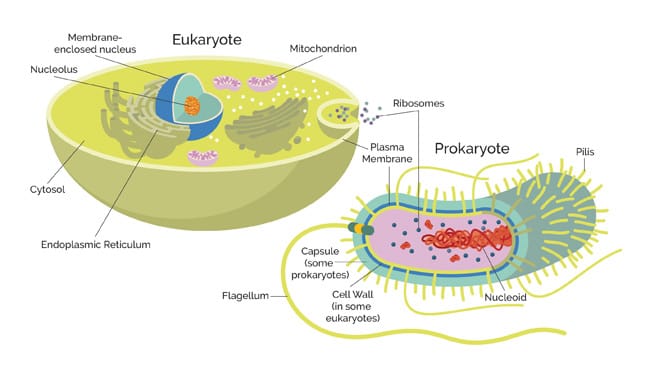Prokaryotes and eukaryotes are the two classes into which all living things can be divided based on the basic makeup of their cells. Prokaryotes and eukaryotes are organisms consisting of cells that don’t have cell nuclei or any organelles that are enclosed in membranes. Eukaryotes are organisms made up of cells that have membrane-bound organelles and a nucleus that houses genetic material.
Different cell types have various roles. There are two different types of cells based on cellular structure:
- Prokaryotes
- Eukaryotes
Characteristics Of Prokaryotes And Eukaryotes
Prokaryotic Cell
Prokaryotic cells lack a proper nucleus and organelles that are attached to membranes.
The earliest single-celled microbes on Earth are prokaryotic cells. Bacteria and archaea are prokaryotes. Cyanobacteria are among the prokaryotes that carry out photosynthesis.
Characteristics
Different distinctive characteristics are present in prokaryotic cells. The prokaryotic cells’ features are listed below.
- The nuclear membrane is absent.
- Lysosomes, chloroplasts, Golgi bodies, and mitochondria are not present.
- One chromosome contains all of the genetic material.
- They are deficient in the histone proteins, which are crucial parts of eukaryotic chromosomes.
- Amino acids and carbohydrates make up the cell wall.
- Respiratory enzymes are carried via the plasma membrane, which functions as the mitochondrial membrane.
- They divide via binary fission, which is asexual. Conjugation is a part of sexual reproduction.
- The diameter of the cells varies from 0.1 to 0.5 m.
- DNA or RNA may make up the hereditary material.
- Prokaryotes often reproduce asexually through a process known as binary fission.

Eukaryotic Cells
Organelles and a membrane-bound nucleus are found in eukaryotic cells.
Large and complex creatures are made up of eukaryotic cells, which have a nucleus surrounded by the nuclear membrane. Eukaryotic cells are found in fungi, plants, mammals, and protozoa. They are categorized as belonging to the Eukaryota kingdom.
Characteristics
- The nuclear membrane encloses the nucleus in eukaryotic cells.
- In a eukaryotic cell, the locomotory organs are flagella and cilia.
- The outermost layer of eukaryotic cells is called a cell wall.
- The process of mitosis is how cells divide.
- The cytoskeleton is present in eukaryotic cells.
- All of the genetic information is contained in a single, linear DNA found in the nucleus.
- The cells have a diameter that varies from 10 to 100 m.
- This large category includes animals, plants, fungus, and protozoa.
- The transfer of nutrients and electrolytes into and out of the cells is observed by the plasma membrane. Additionally, it is in charge of cell-to-cell communication.
- They can reproduce both sexually and asexually.
- Plant and animal cells have some distinct differences. For instance, whereas animal cells lack chloroplasts, central vacuoles, and other plastids, plant cells do.
Also Read About:

